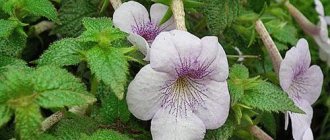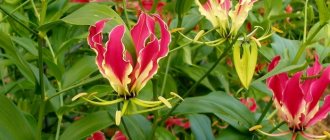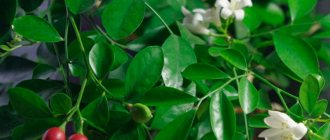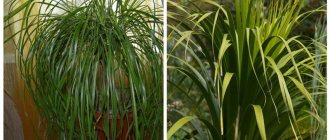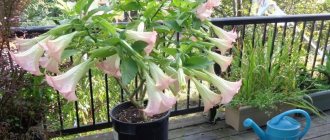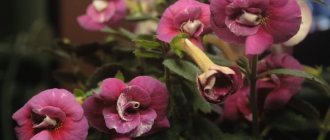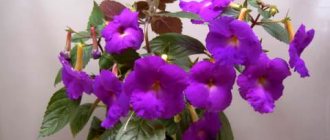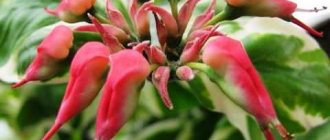Achimenes is a beautiful flowering plant from the Gesneriaceae family. Under natural conditions it occurs as a vine or shrub .
Achimenes is native to the tropical zones of Central and South America. A flower accustomed to a hot, humid climate is afraid of a drop in temperature. This is evidenced even by its name, which goes back to Greek roots and means “afraid of the cold.” Achimenes is developing intensively. It is quite easy to grow it at home. A bush up to 60 cm high can be formed in one growing season. The perennial plant blooms in waves, forming velvety, bright bells from June to September. After this, the aboveground part dies, and in the spring it is reborn from the rhizome.
Be sure to pay attention to such wonderful plants as Columnaea and Saintpaulia.
| Achimenes is developing intensively. |
| It blooms in waves, forming velvety bright bells from June to September. |
| The plant is easy to grow, there are some minor difficulties. |
| The plant dies back every fall and grows back in the spring from old rhizomes. |
Beneficial properties and toxicity of Achimenes
Achimenes.
Photo Achimenes pleases the eye not only with bright bell-like flowers, but also with serrated velvety leaves. Their front side is bright green, and the bottom has a reddish tint. Contemplating original flowers against a background of lush greenery brings incomparable pleasure. Lush bushes in hanging flowerpots decorate the interior. Achimenes is a non-poisonous plant that does not cause allergies or irritation. Therefore, you can safely grow it at home.
Soil and pot
Growing achimenes from rhizomes will be successful only if all the rules, which also apply to the land and container, are followed.
The soil for planting is selected to be loose and nutritious. But you should not be overzealous with organic components when making the soil yourself. It is better to purchase a substrate for flowering ones. It will contain all the necessary components for the development of the flower. 8 rhizomes are planted in one pot. But there are also certain standards for landing. Place 4 pieces in a pot with a diameter of 10 cm. The pots are chosen to be wide and shallow, because the roots of the flower are located on the surface. We must not forget about the drainage holes through which excess water will drain after watering.
Caring for Achimenes at home. Briefly
A tropical plant, Achimenes, can be grown at home by a beginner, having familiarized itself in advance with the preferences of the flower:
| Temperature | The rest period is + 13 - 15°C, the rest of the time - about + 20°C. |
| Air humidity | More than 50%; you cannot spray the plant; placed on a tray with wet pebbles. |
| Lighting | Bright diffused; shade on windows facing south; on windows on the north side it will develop slowly. |
| Watering | The soil must be moist; During flowering, water every 3 days. |
| Priming | A self-prepared mixture of equal doses of humus, peat, sand or a ready-made substrate for Saintpaulia. |
| Feeding and fertilizer | With diluted liquid fertilizer: at the beginning of March - once every 1.5 months; during active growth - 4 times a month. |
| Transfer | Annually. |
| Reproduction | By seeds, rooting cuttings, dividing the bush. |
| Features of cultivation | The plant has adapted to life indoors, but it is important to observe some of the peculiarities of growing Achimenes in order to create comfortable conditions for it. Achimenes needs a period of rest and expresses this by losing its aerial part. In summer, a flower planted in a hanging container feels great outdoors (the place should be bright and protected from drafts). If you pinch the tops of the shoots several times, you can form a beautiful spherical bush. |
Rhizomes - what are they, photo
This is a scaly rhizome that retains signs of life while the flower is in the dormant stage. Depending on the type of plant and the cultivation conditions created, they may not show signs of their vital activity for up to six months.
Usually this period of rest begins from the moment the daylight hours decrease. That is, in the regions of Russia it begins in the second half of autumn, and lasts until the onset of spring, until the spring sun warms up.
Actually, these are the same seeds, they just appear on the dying rhizome of the plant.
Rhizomes of Achimenes in the photo:
Caring for Achimenes at home. Details
Homemade achimenes will delight you with abundant and long-lasting flowering for many years if you surround it with care.
Achimenes flowering
The long, beautiful flowering of Achimenes is one of its brightest advantages. From the end of May to the beginning of November, velvety delicate flowers, similar to bells, appear against the background of green pubescent foliage .
They can be small (up to 3 cm), medium (almost 4 cm) and large (almost 5 cm); simple or terry.
Under natural conditions, violet-colored Achimenes is found. Flowers of different colors are grown in the culture. In the first half of summer, Achimenes blooms more profusely. The flowers fall quickly, but new ones form immediately.
Therefore, the bush always looks elegant. Insufficiently abundant flowering can be caused by:
- excess nitrogen fertilizers;
- lack of light;
- late awakening from hibernation;
- fungal disease.
To help the plant cope with such difficulties, it is moved to a brighter place; fertilize with potassium-phosphorus fertilizer; treated with fungicide, if necessary.
Temperature
In winter, during the dormant period, Achimenes is kept at + 13 - 15 ° C, the rest of the time - at + 20 ° C. Caring for achimenes at home requires observance of this temperature regime. If it is hot in summer (from + 28°C), the color of the flowers may suddenly change and their size will decrease.
A winter increase in temperature will provoke an early awakening of the buds, and shoots will begin to appear ahead of time.
Spraying
All plants of the Gesneriaceae family love high air humidity, more than 50%. In this case, spraying the plant is unacceptable. You can only spray the air around the achimenes if it is not blooming at this time. To increase humidity, place the flower pot on a tray with wet pebbles or use a humidifier. If during watering droplets of water accidentally fall on the leaves, they should be blotted immediately with a clean napkin.
Lighting
The plant is suitable for bright, diffused lighting . On a south-facing window, the achimenes are shaded so that the aggressive rays of the sun do not cause burns. On windows on the north side the flower will be weak and elongated due to lack of light. The Achimenes flower grows well at home on windows facing east and west.
Watering
The substrate must be kept moist. During the flowering period, Achimenes is watered at home once every 3 days with settled lukewarm water .
It is necessary to water evenly and carefully, without spilling water on the leaves. Experienced flower growers use wick irrigation.
Water is poured out of the pan. In winter, Achimenes is not watered, only sometimes the soil is sprayed.
Achimenes pot
The root system of Achimenes is located in the upper part of the substrate, without penetrating deeper. Therefore, the pot for achimenes is chosen to be wide and low. If Achimenes is grown as an ampelous plant, a hanging flowerpot is perfect, from the edges of which green shoots with bright bell-shaped flowers will descend in a beautiful cascade. Whatever pot you choose for achimenes, drainage holes should be made at the bottom to prevent moisture stagnation.
Soil for Achimenes
Achimenes needs a loose nutrient substrate that has a slightly acidic reaction. You can prepare the soil for achimenes at home yourself by taking equal parts of peat, sand (perlite) and humus (you can add leaf soil to the mixture in the same amount). The prepared soil is mixed well and fried or frozen a day before planting. You can buy substrate for Saintpaulia in the store. Crushed moss, brick chips and coal powder are added to the soil.
Feeding and fertilizer
To strengthen the immunity of Achimenes and make it more decorative, fertilize and fertilize it with a special solution for Gesneriaceae or a universal remedy for indoor flowers. They can be alternated with fertilizer for beautifully flowering plants, containing large quantities of phosphorus and potassium.
At the beginning of spring, when the first shoots form, feed once every 10 days. During the growing season - from mid-April to mid-October - every 7 days. After evening watering, Achimenes is “treated” to any diluted liquid fertilizer.
Transplantation of Achimenes
Achimenes is replanted every year, starting in the second half of February, when the flower begins to wake up from hibernation.
The rhizome is removed from the substrate and damaged fragments are removed. A drainage layer is poured onto the bottom of the pot, and prepared soil is placed on it. Make a small depression and place rhizomes (nodules) there. Water from below so as not to bury it. Sprinkle soil on top (1.5 cm). In 2 weeks, shoots will appear. At the same time, Achimenes was fed for the first time.
If the plant has grown during the season, it is carefully transferred to another pot. It is better to do this before Achimenes begins to prepare for hibernation - before the second half of August.
How to prune achimenes?
The main way to form a beautiful, abundantly flowering bush is to prune it. The procedure is carried out for the first time when Achimenes begins the growing season, and the last time - during the appearance of buds - in early May. Trimming the tips of branches leads to the formation of new shoots. The more pairs of leaves are formed, the more fresh buds will appear. The cut pieces can be rooted.
Is it possible to leave Achimenes without care during the holidays?
If you plan to go on vacation in winter or late autumn, there is no need to worry about the flower. It will survive the dry period. If the vacation is scheduled for the summer, then in 2 weeks without watering in the heat you can lose Achimenes. Therefore, the owners need to take care of preserving moisture in the soil before leaving. Unopened buds and some leaves are cut off from the flower so that it evaporates less moisture. Water well and place in a cool, less lit place (on the floor).
It is useful to place a flowerpot with a flower in a large container, place wet sphagnum in the spaces between the walls, place the entire structure on a tray with wet pebbles (so that water from the tray does not flood the soil in the flowerpot through the drainage hole). You can water the plant using wicks.
Achimenes in winter. Rest period
Achimenes are kept in special conditions in winter. The dormant period can last up to six months (this depends on storage conditions and the type of flower). After flowering, watering is reduced to a minimum. The above-ground part must dry out, only then is it removed, and the rhizomes (roots) are placed for the winter at + 9 - 17 ° C. They are not removed from the pot, they are transferred to a shaded, cool room and sometimes the soil is sprayed.
You can place the rhizomes in a perforated plastic bag with sphagnum moss or sand (you can add a powdered fungicide to them). In the second half of February, the roots begin to sprout. If this happened earlier, they are removed to a colder place. If rhizomes, on the contrary, need to be awakened, the bag with them is placed closer to the heat.
Description
- The stems of the plant may be different. There are branched ones. You can find creeping ones.
- The foliage is quite soft to the touch. If you look closely, you can see a small fluff. There are small teeth along the edges.
- The flowers are bright and very beautiful. They can be white, pink, and yellow. They are shaped like bells. Flowers fall off after a short period of time. However, while some are fading, others are just opening up. This continues throughout the growing season.
If you properly care for the plant, it will bloom even twice a year. It will bloom for the first time either in late spring or June. It is important not to overlook this moment, since the second flowering will not be so bright and lush. At the same time, it will bloom a second time in at least three months.
This is not a demanding plant. However, there are some features that need to be taken into account when caring. Firstly, the air must be humidified. Secondly, temperature changes are unacceptable. Also, achimenes should not be placed in a draft. This will also have a detrimental effect on him.
It is a perennial, so when cold weather arrives it does not die, but only falls asleep for a while. Growth stops, the leaves wither and become dry. As soon as spring comes, the plant gradually wakes up. The warmer it gets, the faster the leaves come to life.
With the onset of winter, the containers in which the achimenes are located must be put in a dark place. In this case, it is necessary to carefully monitor the soil. If it is noticeable that it is drying out, then it needs to be moistened.
Another advantage of this flower is that in winter you do not need to clear the windowsill for it. You just need to put it away somewhere for a while, and take it out in the spring - and it will already be all in bloom. Photo of Achimenes - a description of how this plant will develop.
Reproduction of Achimenes
Reproduction of Achimenes, like all Gesnerievs, is possible in different ways, but two are more often used.
Growing Achimenes from seeds
Long way to bloom. At the end of February, fresh seeds are sown superficially. After spraying the soil, the container is covered with film (it is removed for watering and ventilating the seedlings). When shoots appear after 2.5 weeks, the film is removed. When 3 leaves are formed, the seedlings are planted in separate pots. Achimenes will bloom in a year.
Propagation of Achimenes by cuttings
A popular option for propagating rare species. A cutting of at least 5 cm in length is cut from the tops. The lower leaves are removed and placed in warm water with the addition of charcoal powder. In the light, the roots will appear after about 10 days. The rooted cuttings are planted in the ground. Can be propagated by leaf cuttings. The leaf is placed in moistened soil and covered with film. When the roots appear, they are planted in a separate pot. After a few months, the pot is changed to a larger one. If buds appear in the first year, they must be cut off: the task of achimenes at this time is the formation of rhizomes.
Seed propagation leads to the loss of varietal originality of the plant, so it is rarely used.
How to store
It is clear from Achimenes that he is about to go into the dormant stage if:
- the budding stage ends;
- the green mass no longer grows;
- the lower tier of leaves withers and crumbles;
- the soil requires less moisture, since the plant consumes less water.
If the bush itself begins to prepare for the dormant period, then the grower reduces watering so as not to flood the plant. This is done so that the rhizomes of Achimenes ripen and can survive the winter. If the difference between day and night temperatures is only 5°, then stop watering the bush altogether.
In order for the rhizomes to better survive the winter, you need to wait until the bush dries out completely before digging them up. This will indicate that the bush is ready for winter.
In a pot
Depending on how many pots of plants the grower has, he can store them in the ground. To do this, you need to remove all the dry parts of the plant, and move the container to a cool room, where it will be cool and dry in winter.
The temperature in the storage area should not fall below 10° C and not rise above 18°, as this will provoke Achimenes rhizomes to awaken prematurely. Lighting in the storage area is not a necessary factor. But it is impossible to fertilize and water, since the roots are dormant, and moisture in the ground will lead to their rotting. The rhizome of an adult plant is stored in this form.
If this is a young specimen, then the rhizomes are very small, so the plant will not survive a completely cold winter.
Therefore, the container with the young specimen is left in the apartment and slightly moistened during the winter. A bathroom is good if it does not have radiators. In this case, the container is placed under the bath, where it is cool and humid. But from time to time you need to take out the container, and if sprouts appear, then move it to a bright room.
Outside the pot
If the collection of plants is large enough, then storing all the rhizomes in pots is very troublesome and there may not be enough space in a cool room. Therefore, when the plant dries out completely, the following measures must be taken:
- Remove it from the ground.
- Free the rhizome completely from the soil.
- Sort through and keep only healthy specimens for storage.
- Dry.
If the specimens are affected by rot, the diseased parts are cut out and treated with an appropriate fungicide. When the rhizome is ready for storage, that is, processed and dried, it is laid out in sealed bags and sprinkled with perlite. After which you need to sign the packages so that you know which variety is stored where. Then everything is put in one layer in a box or paper box and sent for storage in the basement.
If condensation appears in the bags, they must be opened and the rhizome dried. If this is not done, premature growth may begin.
Diseases and pests
If you carelessly care for a plant, it will be plagued by diseases and pests, as evidenced by unpleasant symptoms:
- spots on the leaves of Achimenes - from watering with cold water or excess sunlight (adjust watering, shade the plant);
- Achimenes flowers quickly fall off - excess light (move to the shade);
- Achimenes is deformed, leaves of Achimenes fall off - damage by pests (insecticides are used);
- Achimenes leaves turn yellow - decreased photosynthesis due to iron deficiency or watering with hard water (feed with fertilizer containing iron; settle water for irrigation, soften with citric acid - 0.2 g per liter of water);
- the leaves are brown and curl - a sharp change in temperature, keeping the plant in a cool, damp room (move to a dry, warm place, protected from drafts and temperature changes).
Achimenes is sometimes affected by pests: aphids, mealybugs, thrips, spider mites.
Types of Achimenes domestica with photos and names
In the natural environment, up to 50 species of Achimenes are found. It is difficult to count the exact number of varieties bred by breeders. It is known that the Romanian breeder S. Salib alone has more than 200 varieties of Achimenes bred. All hybrid varieties are obtained on the basis of 2 original species:
Achimenes grandiflora
The bush grows up to 65 cm. The edges of the pubescent leaf plate are “decorated” with neat teeth. The lower part has a dark red tint. The length of the leaf reaches 10 cm. In the axils of the leaves, 2 scarlet flowers are formed, with a bag-like swelling at the base of the corolla. Popular hybrids: Paul Arnold (bright pink flowers, bronze leaves) and Little Beauty (carmine-colored flowers).
Long-flowered Achimenes (Achimenes longiflora)
The height of the bush is about 35 cm. Oblong purple flowers are formed 1 at a time in the axils of the leaves. The length of the corolla is up to 5 cm. The pubescent green shoots are weakly branched. The elongated, velvety leaves have serrated edges.
It’s not for nothing that Achimenes is called a magic flower. A large spherical bush or a lush cascade descending along the edges of a hanging flowerpot have enchanting beauty and will not leave anyone indifferent.
